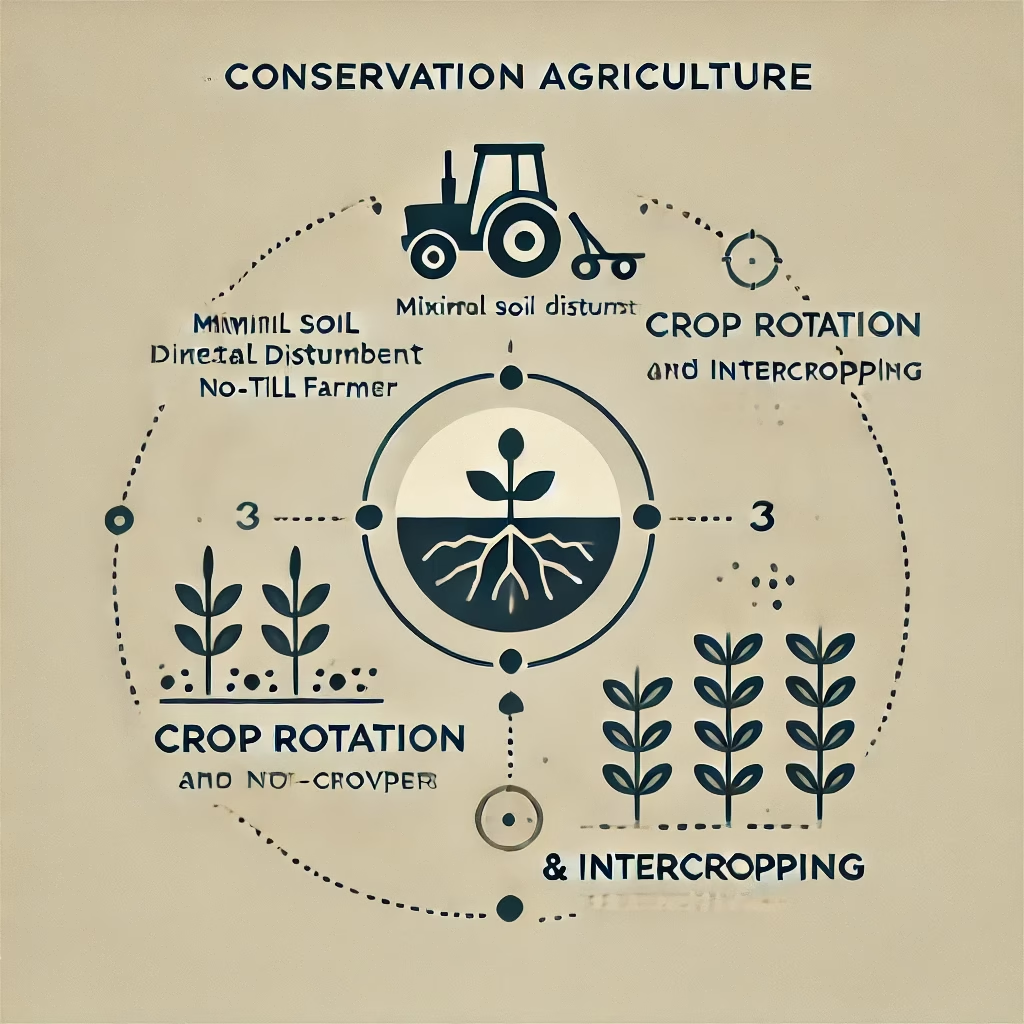Introduction
Agriculture faces unprecedented challenges in the 21st century, including soil degradation, water scarcity, climate change, and the need to feed a growing global population. Conventional agricultural practices, characterized by intensive tillage, monocultures, and heavy reliance on external inputs, have contributed to environmental degradation while threatening long-term productivity. Conservation Agriculture (CA) has emerged as a sustainable alternative that addresses these challenges by focusing on minimal soil disturbance, permanent soil cover, and crop diversification. This article examines the principles, practices, and benefits of Conservation Agriculture, along with implementation challenges and future directions for research and policy.

Core Principles of Conservation Agriculture
Conservation Agriculture is built upon three interlinked principles that work synergistically to enhance agricultural sustainability:
- Minimal Soil Disturbance
The first principle involves reducing or eliminating tillage operations to maintain soil structure and biological activity. Conventional tillage disrupts soil aggregates, accelerates organic matter decomposition, and damages soil biota. In contrast, minimal tillage or no-till practices preserve soil structure, enhance water infiltration, and protect soil organisms. Research has shown that no-till systems can reduce soil erosion by 80-90% compared to conventional tillage while improving soil carbon sequestration by 0.2-0.7 tons per hectare annually. - Permanent Soil Cover
Maintaining crop residues or cover crops on the soil surface throughout the year provides multiple benefits. This protective layer shields soil from erosion, reduces evaporation, moderates soil temperature, suppresses weeds, and contributes organic matter. Studies indicate that maintaining at least 30% soil cover can reduce erosion by 50-90% compared to bare soil, while also enhancing water infiltration by 35-45%. - Crop Diversification
Diversifying crops through rotation, intercropping, or relay cropping breaks pest and disease cycles, improves nutrient cycling, and enhances biodiversity. Crop diversification reduces dependency on external inputs while improving system resilience. Research demonstrates that diverse rotations can increase yields by 10-25% compared to monocultures while reducing fertilizer requirements by 15-30%.
Implementation Practices and Technologies
Several key practices and technologies facilitate the implementation of Conservation Agriculture:
- Specialized Equipment
No-till seeders and planters are designed to cut through crop residues and place seeds at appropriate depths without disturbing the entire soil surface. These specialized implements create narrow slits or small holes for seed placement while maintaining soil cover. Recent innovations include precision planters with sensors that adjust seeding depth based on soil conditions, improving germination rates in variable environments. - Residue Management
Effective residue management is critical for successful CA implementation. This involves proper harvesting techniques that distribute residues evenly across fields and may include specialized equipment such as residue spreaders or choppers. The goal is to maintain 30-100% soil cover while avoiding problems with subsequent planting operations. Research indicates that maintaining 4-6 tons of residue per hectare provides optimal soil protection while allowing effective seeding. - Cover Crop Systems
Cover crops complement CA by providing soil cover during periods when main crops are not growing. Species selection depends on specific objectives such as nitrogen fixation (legumes), biomass production (grasses), or weed suppression (allelopathic species). Termination timing and methods are crucial for maximizing benefits while avoiding competition with subsequent crops. Studies show that well-managed cover crop systems can contribute 50-200 kg of nitrogen per hectare while reducing erosion by up to 95%. - Integrated Weed Management
Without tillage for weed control, CA systems require alternative approaches to weed management. These include strategic crop rotations, competitive cover crops, precise herbicide application, and mechanical methods such as roller-crimpers. Research demonstrates that integrated weed management in CA can achieve equivalent or better weed control than conventional systems while reducing herbicide use by 20-60% over time. - Nutrient Management
CA alters nutrient cycling dynamics, requiring adjustments to fertilization strategies. Initially, nitrogen may need to be increased by 10-20% to compensate for immobilization in surface residues, but requirements typically decrease over time as soil organic matter increases. Precision application technologies such as variable-rate applicators and enhanced efficiency fertilizers complement CA by improving nutrient use efficiency.
Ecological and Agronomic Benefits
Conservation Agriculture provides numerous benefits that enhance agricultural sustainability:
- Soil Health Enhancement
CA practices promote soil biological activity, with studies documenting 2-3 times higher earthworm populations and 40-100% increases in microbial biomass compared to conventional systems. This biological activity improves nutrient cycling, disease suppression, and soil structure. Long-term CA fields typically show 20-40% higher soil organic matter in the top soil layer compared to conventionally tilled fields. - Water Conservation and Management
Improved soil structure and surface residues enhance water infiltration while reducing evaporation. Research indicates that CA systems can increase water infiltration rates by 59-100% and available soil water by 25-40% compared to conventional tillage. This water conservation is particularly valuable in rainfed systems and drought-prone regions, where yield advantages of CA can reach 50-100% during dry years. - Climate Change Mitigation and Adaptation
CA contributes to climate change mitigation through carbon sequestration and reduced fossil fuel consumption. Studies estimate that widespread adoption of CA could sequester 0.4-1.2 billion tons of carbon dioxide equivalent annually. Simultaneously, CA enhances climate resilience through improved water efficiency and soil quality, with research showing 20-40% less yield variability during extreme weather events. - Biodiversity Conservation
The combination of minimal disturbance, permanent cover, and diverse rotations creates favorable habitats for beneficial organisms. Research documents 2-5 times higher arthropod diversity and 20-50% more bird species in CA fields compared to conventional systems. This biodiversity provides ecosystem services such as pest control and pollination, reducing dependency on external inputs. - Economic Benefits
While economic outcomes vary by context, CA typically reduces production costs through decreased fuel consumption (50-80%), reduced labor requirements (30-50%), and lower machinery wear. After the transition period, yields are generally maintained or increased, particularly in challenging environments. Long-term studies show 10-20% higher profit margins in established CA systems compared to conventional practices.
Implementation Challenges and Solutions
Despite its benefits, Conservation Agriculture faces several implementation challenges:
- Transition Period
The shift to CA often involves a 3-5 year transition period during which soil properties and biological systems adjust. During this time, farmers may experience temporary yield reductions or weed management challenges. Phased implementation approaches, targeted incentives, and farmer-to-farmer knowledge networks can help overcome transition barriers. Research shows that combining CA with precision nutrient management can minimize or eliminate yield penalties during transition. - Knowledge and Skill Requirements
CA requires different management skills and knowledge compared to conventional agriculture. Farmers need to understand complex ecological interactions and develop expertise in areas such as cover crop management and integrated pest management. Farmer field schools, demonstration plots, and participatory research have proven effective in building capacity, with studies showing 40-60% higher adoption rates following participatory learning approaches. - Equipment Access and Adaptation
Specialized equipment for CA can represent a significant investment barrier, particularly for smallholder farmers. Solutions include equipment sharing arrangements, custom hiring services, and adapting existing implements for CA functions. Research from developing countries demonstrates that locally adapted CA equipment can reduce costs by 60-80% while maintaining effectiveness. - Context-Specific Adaptation
CA principles must be adapted to local agroecological and socioeconomic conditions. What works in large-scale mechanized systems may not be appropriate for smallholder contexts. Participatory innovation approaches that combine scientific knowledge with local expertise have shown 30-50% higher success rates than top-down technology transfer models. - Policy and Institutional Support
Enabling policies and institutional arrangements are crucial for widespread CA adoption. These include research and extension services, appropriate subsidy structures, and payment for ecosystem services. Countries with supportive policy frameworks have achieved 3-5 times higher adoption rates compared to those without such support.
Future Directions
Several emerging trends and research areas are shaping the future of Conservation Agriculture:
- Digital Agriculture Integration
The integration of digital technologies such as remote sensing, machine learning, and decision support systems is enhancing CA implementation. These technologies enable site-specific management, real-time monitoring, and predictive analytics. Early adopters report 15-30% improvements in input efficiency and 10-20% yield increases through precision CA approaches. - Biological Inputs and Biostimulants
Advances in microbial inoculants, biofertilizers, and biostimulants complement CA by enhancing soil biological functions. Research shows that combining CA with biological inputs can accelerate soil health improvements by 30-50% while further reducing dependency on synthetic inputs. - Climate-Smart CA Innovations
Evolving CA systems are increasingly focused on climate resilience through innovations such as drought-tolerant varieties, water harvesting techniques, and agroforestry integration. These climate-smart CA approaches have demonstrated 30-60% higher resilience to extreme weather events compared to conventional systems. - Landscape-Level Implementation
Moving beyond field-scale applications, landscape approaches to CA consider watershed dynamics, habitat connectivity, and collective action. Research indicates that landscape-level CA implementation can amplify benefits by 20-40% through reduced erosion, improved water management, and enhanced ecosystem services. - Policy and Market Integration
Emerging carbon markets, sustainability certification schemes, and ecosystem service payment programs are creating new incentives for CA adoption. Pioneering initiatives demonstrate that farmers can receive premiums of 5-15% for products from certified CA systems, providing additional economic motivation for adoption.
Conclusion
Conservation Agriculture represents a paradigm shift from conventional agricultural approaches toward systems that work with natural processes rather than against them. By adhering to the principles of minimal soil disturbance, permanent soil cover, and crop diversification, CA offers a pathway to address multiple agricultural challenges simultaneously. The evidence demonstrates that well-implemented CA systems can enhance soil health, conserve water, mitigate climate change, protect biodiversity, and improve farmer livelihoods.
However, realizing these benefits requires context-specific adaptation, knowledge-intensive management, and supportive policies. The future of CA lies in its integration with complementary innovations such as digital agriculture, biological inputs, and landscape approaches. As global agriculture faces mounting pressures from environmental degradation and climate change, Conservation Agriculture provides a scientifically sound and practically proven approach to sustainable food production that can help feed humanity while regenerating the natural resource base upon which agriculture depends.
References
- Kassam, A., Friedrich, T., & Derpsch, R. (2019). Global spread of Conservation Agriculture. International Journal of Environmental Studies, 76(1), 29-51.
- Pittelkow, C. M., Liang, X., Linquist, B. A., Van Groenigen, K. J., Lee, J., Lundy, M. E., van Gestel, N., Six, J., Venterea, R. T., & van Kessel, C. (2015). Productivity limits and potentials of the principles of conservation agriculture. Nature, 517(7534), 365-368.
- Thierfelder, C., Baudron, F., Setimela, P., Nyagumbo, I., Mupangwa, W., Mhlanga, B., Lee, N., & Gérard, B. (2018). Complementary practices supporting conservation agriculture in southern Africa. A review. Agronomy for Sustainable Development, 38(2), 16.
- Palm, C., Blanco-Canqui, H., DeClerck, F., Gatere, L., & Grace, P. (2014). Conservation agriculture and ecosystem services: An overview. Agriculture, Ecosystems & Environment, 187, 87-105.
- Gonzalez-Sanchez, E. J., Veroz-Gonzalez, O., Conway, G., Moreno-Garcia, M., Kassam, A., Mkomwa, S., Ordoñez-Fernandez, R., Triviño-Tarradas, P., & Carbonell-Bojollo, R. (2019). Meta-analysis on carbon sequestration through Conservation Agriculture in Africa. Soil and Tillage Research, 190, 22-30.
- Jat, M. L., Chakraborty, D., Ladha, J. K., Rana, D. S., Gathala, M. K., McDonald, A., & Gerard, B. (2020). Conservation agriculture for sustainable intensification in South Asia. Nature Sustainability, 3(4), 336-343.
- Lal, R. (2015). Sequestering carbon and increasing productivity by conservation agriculture. Journal of Soil and Water Conservation, 70(3), 55A-62A.
- Corbeels, M., Naudin, K., Whitbread, A. M., Kühne, R., & Letourmy, P. (2020). Limits of conservation agriculture to overcome low crop yields in sub-Saharan Africa. Nature Food, 1(7), 447-454.
- Hobbs, P. R., Sayre, K., & Gupta, R. (2008). The role of conservation agriculture in sustainable agriculture. Philosophical Transactions of the Royal Society B: Biological Sciences, 363(1491), 543-555.
- Giller, K. E., Andersson, J. A., Corbeels, M., Kirkegaard, J., Mortensen, D., Erenstein, O., & Vanlauwe, B. (2015). Beyond conservation agriculture. Frontiers in Plant Science, 6, 870.
If you want to learn more about Conservation Agriculture, check out Agri AI : Smart Farming Advisor and feel free to ask any questions!

Leave a Reply